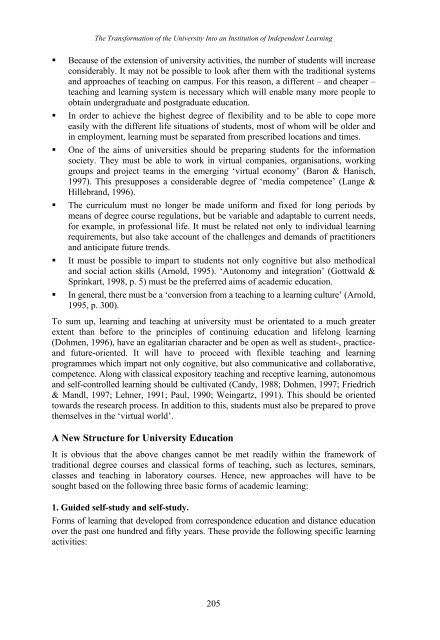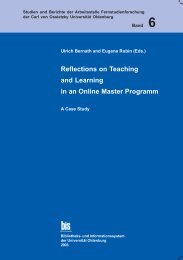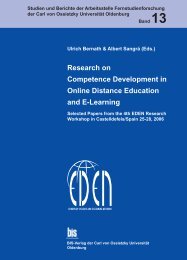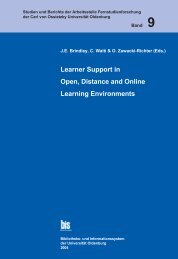Distance Education in Transition - Master of Distance Education ...
Distance Education in Transition - Master of Distance Education ...
Distance Education in Transition - Master of Distance Education ...
You also want an ePaper? Increase the reach of your titles
YUMPU automatically turns print PDFs into web optimized ePapers that Google loves.
The Transformation <strong>of</strong> the University Into an Institution <strong>of</strong> Independent Learn<strong>in</strong>g<br />
� Because <strong>of</strong> the extension <strong>of</strong> university activities, the number <strong>of</strong> students will <strong>in</strong>crease<br />
considerably. It may not be possible to look after them with the traditional systems<br />
and approaches <strong>of</strong> teach<strong>in</strong>g on campus. For this reason, a different – and cheaper –<br />
teach<strong>in</strong>g and learn<strong>in</strong>g system is necessary which will enable many more people to<br />
obta<strong>in</strong> undergraduate and postgraduate education.<br />
� In order to achieve the highest degree <strong>of</strong> flexibility and to be able to cope more<br />
easily with the different life situations <strong>of</strong> students, most <strong>of</strong> whom will be older and<br />
<strong>in</strong> employment, learn<strong>in</strong>g must be separated from prescribed locations and times.<br />
� One <strong>of</strong> the aims <strong>of</strong> universities should be prepar<strong>in</strong>g students for the <strong>in</strong>formation<br />
society. They must be able to work <strong>in</strong> virtual companies, organisations, work<strong>in</strong>g<br />
groups and project teams <strong>in</strong> the emerg<strong>in</strong>g ‘virtual economy’ (Baron & Hanisch,<br />
1997). This presupposes a considerable degree <strong>of</strong> ‘media competence’ (Lange &<br />
Hillebrand, 1996).<br />
� The curriculum must no longer be made uniform and fixed for long periods by<br />
means <strong>of</strong> degree course regulations, but be variable and adaptable to current needs,<br />
for example, <strong>in</strong> pr<strong>of</strong>essional life. It must be related not only to <strong>in</strong>dividual learn<strong>in</strong>g<br />
requirements, but also take account <strong>of</strong> the challenges and demands <strong>of</strong> practitioners<br />
and anticipate future trends.<br />
� It must be possible to impart to students not only cognitive but also methodical<br />
and social action skills (Arnold, 1995). ‘Autonomy and <strong>in</strong>tegration’ (Gottwald &<br />
Spr<strong>in</strong>kart, 1998, p. 5) must be the preferred aims <strong>of</strong> academic education.<br />
� In general, there must be a ‘conversion from a teach<strong>in</strong>g to a learn<strong>in</strong>g culture’ (Arnold,<br />
1995, p. 300).<br />
To sum up, learn<strong>in</strong>g and teach<strong>in</strong>g at university must be orientated to a much greater<br />
extent than before to the pr<strong>in</strong>ciples <strong>of</strong> cont<strong>in</strong>u<strong>in</strong>g education and lifelong learn<strong>in</strong>g<br />
(Dohmen, 1996), have an egalitarian character and be open as well as student-, practice-<br />
and future-oriented. It will have to proceed with flexible teach<strong>in</strong>g and learn<strong>in</strong>g<br />
programmes which impart not only cognitive, but also communicative and collaborative,<br />
competence. Along with classical expository teach<strong>in</strong>g and receptive learn<strong>in</strong>g, autonomous<br />
and self-controlled learn<strong>in</strong>g should be cultivated (Candy, 1988; Dohmen, 1997; Friedrich<br />
& Mandl, 1997; Lehner, 1991; Paul, 1990; We<strong>in</strong>gartz, 1991). This should be oriented<br />
towards the research process. In addition to this, students must also be prepared to prove<br />
themselves <strong>in</strong> the ‘virtual world’.<br />
A New Structure for University <strong>Education</strong><br />
It is obvious that the above changes cannot be met readily with<strong>in</strong> the framework <strong>of</strong><br />
traditional degree courses and classical forms <strong>of</strong> teach<strong>in</strong>g, such as lectures, sem<strong>in</strong>ars,<br />
classes and teach<strong>in</strong>g <strong>in</strong> laboratory courses. Hence, new approaches will have to be<br />
sought based on the follow<strong>in</strong>g three basic forms <strong>of</strong> academic learn<strong>in</strong>g:<br />
1. Guided self-study and self-study.<br />
Forms <strong>of</strong> learn<strong>in</strong>g that developed from correspondence education and distance education<br />
over the past one hundred and fifty years. These provide the follow<strong>in</strong>g specific learn<strong>in</strong>g<br />
activities:<br />
205





